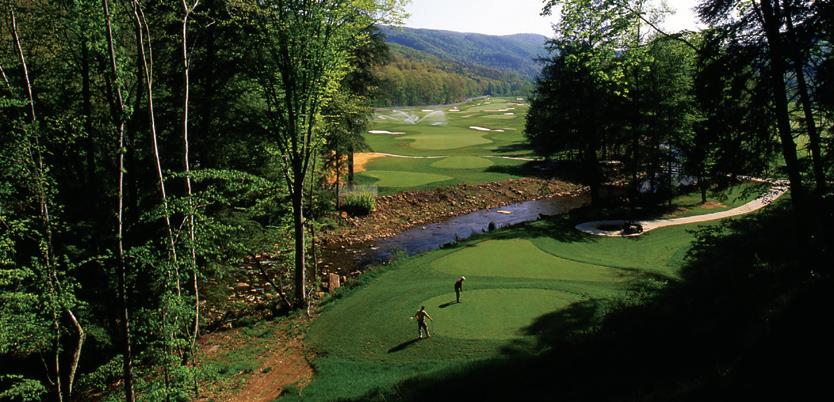
5 minute read
KENTUCKIANA
Kentucky’s golf, park system, horses and whiskey make it a bucket list, which will keep you coming back for more BY TONY DEAR
BY TONY DEAR
Kentucky’s State Parks golf course network never fails to impress. The number and quality of the layouts, which feature a dozen 18-hole facilities designed by Michael Hurdzan, Arthur Hills, Larry Packard, the very underrated Brian Ault and the revered Perry Maxwell among them — the equal of that belonging to pretty much any municipal entity, be it city, county, or state, in the country.
If you have a spare couple of weeks, were up for a different course every day and had a modest budget for the affordable green fees, lodging and a little flutter for the eight horse racing tracks, we recommend you put this place at the top of your list. And, don’t forget Kentucky’s famous bourbon distilleries scattered all over the state.
For the purposes of this issue, we’re going to focus on the eastern quartet of courses — Grayson Lake, Yatesville Lake, Pine Mountain and General Burnside Island, which a whopping 99 percent of GolfPass readers who reviewed the course would recommend you play.
Located on a 430-acre island (like at the 17th at TPC Sawgrass, a causeway connects the ‘island’ to the mainland) on Lake Cumberland, formed by construction of the Wolf Creek Dam in 1952, the golf course at General Burnside State Park first opened as a nine-holer in 1950 — eight years before the Corps of Engineers transferred the land to the State of Kentucky.
Originally named in honor of Kentucky Governor A.B. Chandler, its name was changed in 1960 to recognize Civil War Union General Ambrose Burnside whose unconventional facial hair eventually led to the term ‘sideburn.’ A 20-minute drive south of the city of Somerset and 140 miles southeast of Louisville, the course was redesigned in 2008 by Brian Ault, who served as President of the American Society of Golf Course Architects from 2000-01.

Wasioto Winds Golf Course • Pine Mt., Ky.
Ault spent $7.25 million in totally transforming the course that has generous Zoysia grass fairways and big, bentgrass greens, which all golfers should find eminently playable. Surrounding trees make you forget you’re on a small river-island but occasional glimpses of the water from the course’s higher ground remind you how (nearly) cut off from civilization you are. It’s no surprise this beautiful course wins so many local accolades and has earned a sizable following and an enviable reputation.
The same is true of Arthur Hills’ Eagle Ridge Course at Yatesville Lake, a serpentine reservoir formed by Yatesville Dam, which opened in 1988. Hills’ masterpiece is located on its eastern banks on spectacular ground that Steve Forrest, Hills’ associate designer, describes as “mountainous rather than hilly.”
A course on this sort of land can quickly turn into a survival test rather than an enjoyable round of golf. One considerably up-and-down hole after another can get a little predictable, if not tiresome. Hills, who passed in May of last year, was in his early 70s when the course opened in 2003 and, having designed more than 150 courses by that stage of his career, was an experienced hand who knew just how to make the most of the land without overdoing it.
The thrills come at just the right times and are nicely spaced out, avoiding a huge peak of adrenalin followed by a disappointing collapse and weak finish.
That said, Yatesville is not your typical muni. It’s tight in places and, like we say, quite breathtaking. Bring a good supply of golf balls and plenty of energy, and you might have one of the more memorable rounds of your life.
You’ll not soon forget your visit to Dr. Michael Hurdzan’s Wasioto Winds Course at Pine Mountain State Park either. One of the most prolific and successful designers of the 1990s and early 2000s, Hurdzan is associated with more than 400 projects around the world the most notable of which are the two courses of the Pulpit Club in Ontario, Canada, FarmLinks in Alabama, Naples National in Florida and, of course, 2017 U.S. Open venue Erin Hills.
Also, the designer of the excellent course at Mineral Mound State Park five hours to the west, Hurdzan built five par 3s and five par 5s at Pine Mountain, which cost $10 million to build and opened in 2001. Bisected by Clear Creek, Pine Mountain stretches just beyond 7,000 yards and finishes with an intimidating 639-yard par 5 with water down the right side.
That just leaves Brian Ault’s Hidden Cove Course at Grayson Lake, another narrow, wooded reservoir created by the U.S. Army Corps of Engineers. About an hour northwest of Yatesville and 180 miles east of Louisville, the extremely popular, course opened in 2003 and boasts bentgrass fairways and greens, and a healthy number of really good golf holes.
At some point you’ll want to say you’ve played all of Kentucky State Park’s golf courses, and starting in the east is a heck of a start. For information regarding the courses, greens fees, directions, lodging and more, head to parks.ky.gov/golf.







